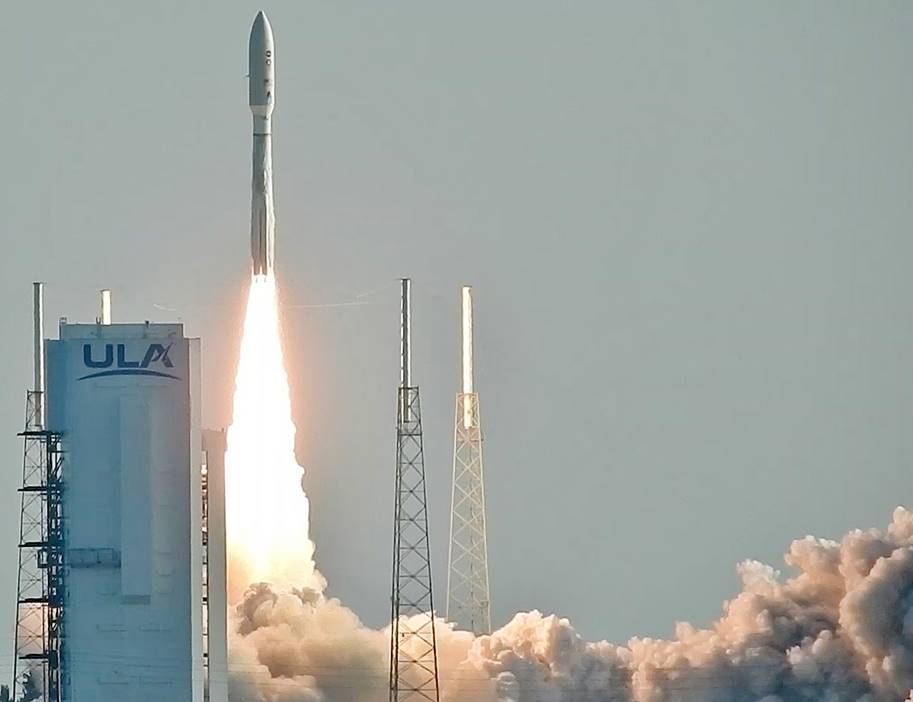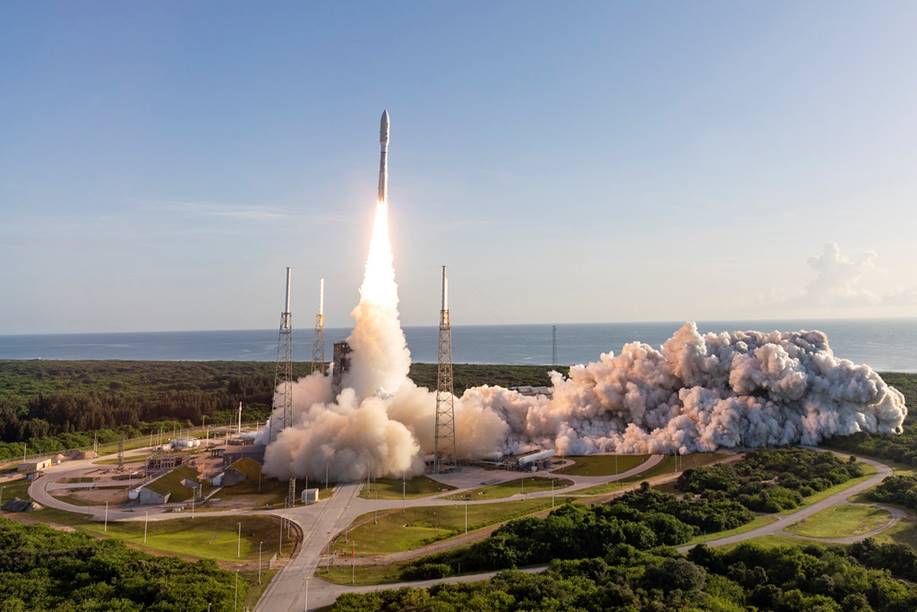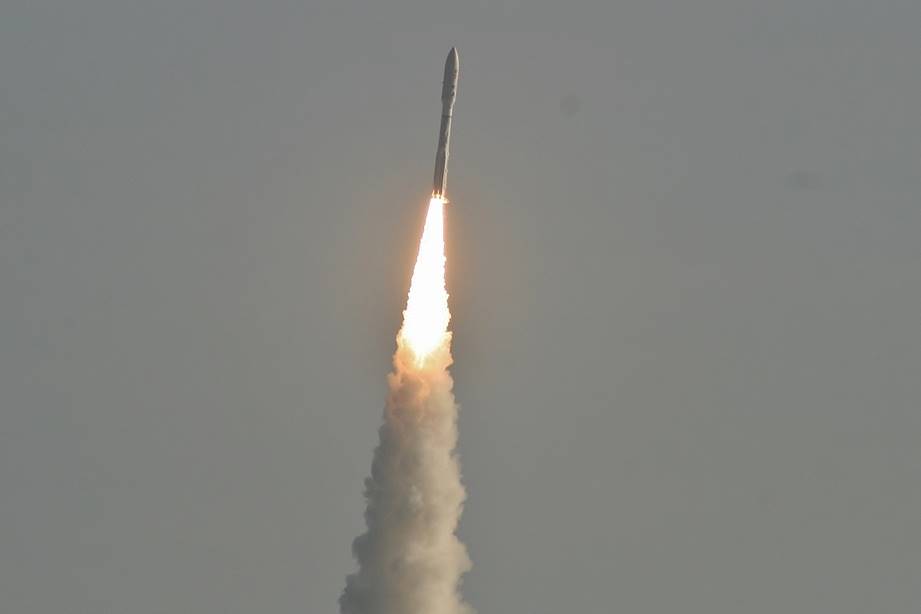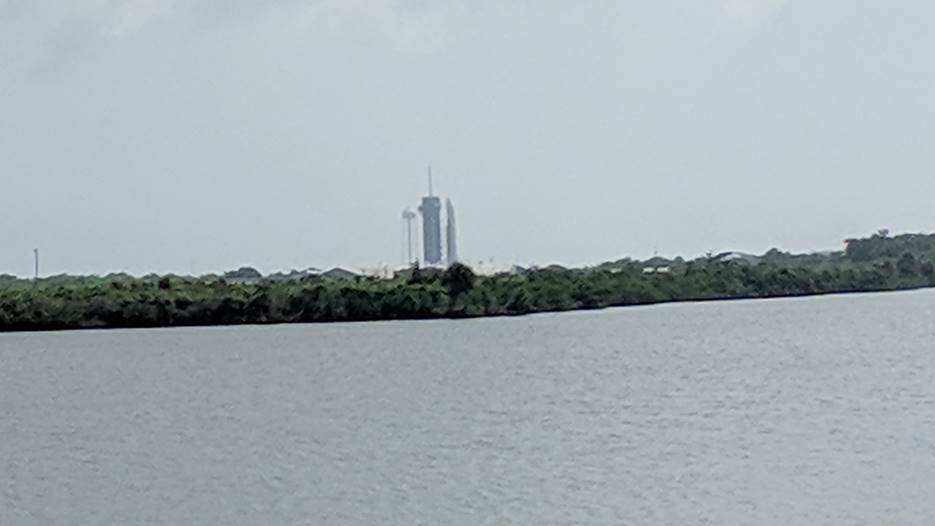
Atlas V Mars 2020/Perseverance Launch, Photo Courtesy Liz Allen/Spaceline
Atlas V Launches Mars 2020/Perseverance Mars Rover
July 30, 2020 | Reported by Cliff Lethbridge
A United Launch Alliance Atlas V rocket successfully launched the Mars 2020/Perseverance Mars rover at 7:50 a.m. EDT today from Launch Pad 41 on Cape Canaveral Air Force Station. Launch was conducted on schedule with no delays. The launch vehicle was the most powerful Atlas V variant, known as Version 541, featuring a five-meter payload fairing, four solid rocket boosters and a single-engine Centaur upper stage. The rocket performed flawlessly during its flight, gingerly carrying aloft the most sophisticated rover ever launched. If all goes according to plans, Mars 2020/Perseverance will land on Mars on February 18, 2021 for a mission lasting one Mars year, or two Earth years. It is designed to explore a geologically diverse landing site, determine ancient habitability, seek signs of ancient microbial life, gather rock and soil samples which may be returned to Earth on a future mission and demonstrate technology for future robotic and human exploration of Mars.

Atlas V Mars 2020/Perseverance Launch, Photo Courtesy United Launch Alliance
Mars 2020/Perseverance uses seven instruments to accomplish its designed tasks. These include the Mastcam-Z, an advanced camera system with panoramic and stereoscopic imaging and zoom capability, SuperCam, an instrument that can provide imaging, chemical composition analysis and minerology at a distance. Specific experiments include Planetary Instrument for X-ray Lithochemistry (PIXL), Scanning Habitable Environments with Raman and Luminescence for Organics and Chemicals (SHERLOC), The Mars Oxygen In-Situ Resource Utilization Experiment (MOXIE), Mars Environmental Dynamics Analyzer (MEDA) and the Radar Imager for Mars Subsurface Experiment (RIMFAX).

Atlas V Mars 2020/Perseverance In Flight, Photo Courtesy Liz Allen/Spaceline
Mars 2020/Perseverance will also test new technology for future robotic and human explorations, including Terrain Relative Navigation, a method of using autopilot to avoid hazards. Also incorporated are a set of sensors for gathering data on landing called the Mars Entry, Descent and Landing Instrumentation-2 (MEDLI-2). A new, sophisticated navigation system will also allow the rover to travel at higher speeds in challenging terrain. Electrical power for the rover is provided by the Multi-Mission Radioisotope Thermoelectric Generator (MMRTG) which uses heat from the decay of plutonium-238 to generate electricity. The car-sized Mars 2020/Perseverance is about 10 feet long, 9 feet wide and 7 feet tall and weighs 2,260 pounds. The project is managed for the NASA Science Mission Directorate in Washington, D.C. by the Jet Propulsion Laboratory (JPL), a division of Caltech in Pasadena, California.

Atlas V Solid Rocket Booster Separation, Photo Courtesy Liz Allen/Spaceline

Launch Of Bumper #8, July 24, 1950, Photo Courtesy U.S. Army
Happy Anniversary, Cape Canaveral!
July 24, 2020 | Reported by Cliff Lethbridge
Today, July 24, 2020 marks 70 years since the first rocket launch from Cape Canaveral, that of Bumper #8, launched from Launch Pad 3 on July 24, 1950. The modified German V-2 rocket paved the way for over 3,600 launches from the Cape that have followed. For detailed information on this historic launch, visit www.spaceline.org/bumper.html. Spaceline wishes Cape Canaveral a Happy Anniversary!

Bumper #8 On Launch Pad 3, Photo Courtesy U.S. Army

Falcon 9 ANASIS-II Launch, Photo Courtesy Cliff Lethbridge/Spaceline
Falcon 9 Successfully Launches South Korean Satellite
July 20, 2020 | Reported by Cliff Lethbridge
A SpaceX Falcon 9 rocket successfully launched the ANASIS-II satellite for South Korea at 5:30 p.m. EDT today from Launch Pad 40 on Cape Canaveral Air Force Station. Launch was originally set for July 14, 2020 but was postponed due to problems with the rocket's second stage. Today's launch was delayed 30 minutes due to an isolated rain shower in the launch area. The first stage booster employed today was launched for the second time, having flown previously for the Crew Dragon Demo-2 manned launch to the International Space Station. The booster was successfully recovered today with a landing on the "Just Read the Instructions" drone ship positioned on the Atlantic Ocean about 400 miles east of Cape Canaveral. In addition, both payload fairing halves were successfully caught by the "Ms. Chief" and "Ms. Tree" vessels. ANASIS-II (Army/Navy/Air Force Satellite Information System-2) was deployed about 32 minutes after liftoff. Formerly known as KMilsatCom-1, the satellite is South Korea's first dedicated military communications satellite. It was built by Airbus Defense and Space under a contract with Lockheed Martin. Specific elements of the satellite are being kept secret.

ANASIS-II Satellite, Photo Courtesy Airbus Defense And Space

Falcon 9 Starlink On Launch Pad, Photo Courtesy Cliff Lethbridge/Spaceline
Falcon 9 Starlink Launch Scrubbed For Third Time
July 11, 2020 | Reported by Cliff Lethbridge
Launch of a SpaceX Falcon 9 rocket scheduled for 10:54 a.m. EDT today has been scrubbed. A scrub announcement was made about two hours prior to the launch, which has already been scrubbed twice before. SpaceX said that today's launch was scrubbed to give the launch team more time for pre-launch checkouts and preparations. The same reason was given for the first scrub on June 26, 2020. Launch was again scrubbed on July 8, 2020 but this time due to bad weather. A rescheduled launch date has not been announced. The rocket will be carrying 57 Starlink broadband satellites and two BlackSky Global Earth-imaging rideshares.

Falcon 9 Starlink On Launch Pad 39A, Photo Courtesy Liz Allen/Spaceline
Falcon 9 Starlink Launch Scrubbed For Second Time
July 8, 2020 | Reported by Cliff Lethbridge
Launch of a SpaceX Falcon 9 rocket from Launch Pad 39A at the Kennedy Space Center scheduled for 11:59 a.m. EDT today has been scrubbed due to bad weather. Rain and clouds were prevalent at the launch site all morning and caused a scrub announcement to be issued about 15 minutes before launch. The countdown was officially halted at T-minus one minute to facilitate data collection activities of the launch team. This is the second scrub of this launch, which was originally set for June 26, 2020, when a scrub was called about three hours before launch to allow more time for pre-launch checkouts and preparations. SpaceX has not yet officially announced a rescheduled launch date, but warnings to Cape Canaveral-area mariners and pilots issued late today indicate that the launch could be scheduled for the morning of Saturday, July 11, 2020. The rocket will be carrying 57 Starlink broadband satellites and two rideshare BlackSky Global Earth-imaging satellites.

Clouds And Rain At Launch Complex 39, Photo Courtesy Liz Allen/Spaceline












